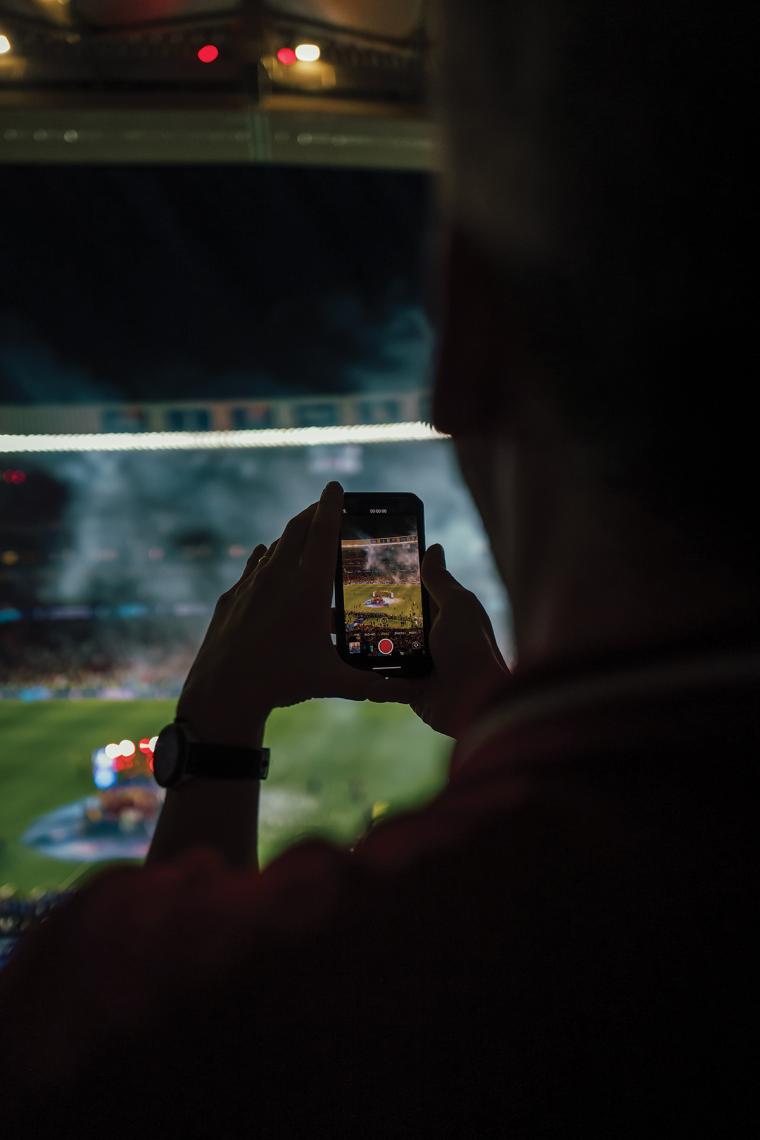

Colleges and universities are considering whether large-scale planned activities will return this fall – not only sporting events, but even large academic lectures or classes. Leaders at these institutions are now trying to determine how – or if it’s even possible – to coordinate athletic events while keeping people safe. This affects event owners since many college venues are typically used to host athletic events.
As event owners try to find their bearings, they are surrounded by the news regarding not just singular colleges and universities, but entire conferences, regarding sports activities. Ivy League colleges announced they will postpone athletics until 2021 due to social distancing and travel restrictions, and several collegiate sports conferences have decided to restrict competition to their respective conferences. Many other institutions are also carefully weighing the decision of whether spectators and fans will be allowed to attend games and competitions, so it remains to be seen how the season will play out across all collegiate sports.
In either scenario, colleges and universities need a comprehensive system to protect the health and safety of students, student-athletes, and fans alike. In this regard, they are no different from event owners. Institutions will need new processes and capabilities for monitoring the impacts of COVID-19, mitigating the risks associated with re-opening facilities, and ensuring proper tracking of important data and information.
Decision-making can be quite complex as there will be numerous guidelines limiting the number of people on campus as well as attending campus events, along with standards for conducting health testing, ensuring facilities safety, performing lockdowns of areas in the event that coronavirus cases occur, and creating and enforcing protocols for social distancing.
There are a lot of moving parts when it comes to athletic events – and more than ever in the COVID-19 age – and nothing can fall through the cracks.
Of course, COVID-19 is not the only crisis situation that athletic organizations need to be prepared for. On any given day, there are unexpected situations that can arise, from natural disasters like severe storms, tornadoes, hurricanes, and floods, to human-caused crises like acts of violence, terrorism, or even cyberattacks – which can cause major disruptions and affect the safety of participants and spectators.
Using Emergency Management Technology to Prepare and Respond
An effective emergency management platform is a valuable tool to prepare for unplanned crisis incidents, as well as supporting day-to-day activities. However, these platforms can be just as effective in planning for planned activities like athletic events and responding to any incident associated with them.
Most know that emergency management platforms are effective in managing response to and recovery from natural disasters as well as human-caused disasters. But they are also instrumental in managing planned events that have the potential to put a strain on community resources, helping to track large numbers of people, and enhancing coordination between agencies and stakeholders. These solutions also promote greater situational awareness and provide many other capabilities to help ensure safety at large events, such as:
- A centralized command center for monitoring events, activities, incidents and coordinating a response
- A common operating picture of all pertinent data, available to all stakeholders, event staff, first responders, etc. – which enables faster, more informed decision making
- Effective communications allowing information to be shared in real time, anywhere, any time, on any type of device.
- Best practices for preparing for emergencies:
Best Practice #1 – Be Prepared
There’s an old saying that has been used by quite a few coaches over the years: “Proper preparation prevents poor performance.” There are several variations of this quote, but it is just as true for emergency preparedness as it is for sports.
To prepare effectively for all the potential threats to public safety, especially in the light of COVID-19 concerns, organizations need to revisit their emergency playbook and review emergency action plans, response guides and other critical processes to make sure that all processes are still relevant and actionable.
Emergency management technology helps organizations pre-plan, identify and prepare for incidents or potential threats to protect athletes, spectators, staff and fans and to determine security and safety objectives and devise ways to enhance cooperation between agencies and stakeholders, and avoid duplication of processes during an event.
Here are some best practices for reviewing emergency plans and procedures:
- Conduct a risk assessment to identify potential emergency threats
- Identify key personnel who will be involved in response to various incidents
- Identify stakeholders and local and state agencies that will be involved
- Create specific plans, procedures and proocols for response
- Establish an incident command center for coordination of response and communications
- Develop procedures for coordinating critical event response across multiple locations
- Compile all forms to be used, including incident reports and forms for insurance purposes
- Seek input on the preparedness plan from all community stakeholders including law enforcement, fire, medical/hospital and public health.
Preparedness plans should include both procedures for creating a safe environment related to COVID-19 precautions, as well as traditional emergency response actions. Ensuring a safe environment for athletics, including amateur sports, requires a clear plan for working with local, state, and federal agencies on processes for reopening. This includes cleaning and disinfecting the workspace or facility, using all applicable guidelines from governing bodies and the CDC, communicating about health threats, tracking and monitoring the health of staff, spectators and athletes, and establishing updated protocols for maintaining safe distancing.
Best Practice #2 – Maintain Situational Awareness
Complete situational awareness is the foundation of emergency management and public safety. Situations and events change rapidly, even more so in the wake of COVID-19. Operational decisions have to be made frequently and quickly and require full understanding of circumstances, data and up-to-the-minute information. Comprehensive situational awareness of these and other campus activities requires all data and information to be centralized so it can be shared quickly and efficiently with key stakeholders so that actions can be taken quickly to respond to any incident.
Having a common operating picture (COP) including a centralized cloud-based solution for information and data available across multiple locations and devices, for organization-wide, community or state level events gives organizations greater situational awareness and ensures that the information is reliable and accurate – and that other stakeholders are all working from the same set of data.
An emergency management platform also offers dashboards with critical information in an easily viewable format, including real-time operational status and visibility of available resources. This helps provide organized summaries or SitReps (situation reports) to get actionable information to the right people in the right positions at the right time for prompt, well organized, and effective incident response.
Using an emergency management platform exponentially increases an organization’s situational awareness capabilities by providing:
- A common operating picture including organization-wide, community and state level events
- Real-time views of operational status and visibility of resources available
- A centralized location for situational awareness, available across multiple locations and devices, at any time
- Ability to simplify processes and to standardize communication effectively with students, athletes, staff and stakeholders during events or emergency situations
- Ability to identify roles and actions of emergency response teams.
Best Practice #3 – Track and Monitor Everything, Centrally
Tracking and monitoring location-specific conditions and people has always been an important aspect of maintaining safety and situational awareness, particularly at athletic events, but with COVID-19 considerations the new normal will necessitate greater diligence and more capabilities than ever before.
Going forward, it will be essential to monitor all information and activities related to the health status and/or maintaining the health and safety of all participants, spectators and staff, as well as the status of many different locations and facilities such as gyms, training facilities, offices, and venues.
Organizations must have the tools necessary to monitor individuals, track facilities status, schedule, perform and track cleaning and sanitizing tasks, monitor supplies of any PPE and more. Protocols and methodologies have to be established to meet any requirements for contact tracing and guidelines must be set up to review and determine if conditions are safe.
Best Practice #4 – Streamline Communication
Another concern is how to quickly and efficiently communicate with emergency teams and all individuals involved on a regular basis about how they can stay safe and healthy during emergencies or in consideration of COVID-19. Athletic organizations need a centralized communication platform with the means to contact everyone who could be impacted and keep them informed constantly and consistently.
A centralized communication platform is critical to contact everyone who could be impacted and keep them informed, including leadership, athletes, spectators, customers, emergency responders and the media. Collaboration and coordination with local, state and federal emergency management, public health agencies and educational agencies will be more vital than ever. Staying connected to these agencies will help ensure everyone is informed with timely information about critical details and data, including the potential for coronavirus infection and possible transmission.
To ensure optimal communications, organizations should:
- Develop communication mechanisms or implement a platform for centralizing information and creating notifications for stakeholders, key incident response personnel and others who are impacted
- Create and keep up-to-date contact lists for communication during and after an emergency or incident
- Be prepared to promptly communicate with leadership, athletes, staff, media or anyone who may have been affected.
Best Practice #5 – Stay Ahead With Pandemic-Specific Workflows
In the spring, as COVID-19 cases were rising rapidly, sports events were put on hold but most were hopeful by fall that all would return to some semblance of normal. Unfortunately, with the recent rise in cases, we’ve seen that the unpredictable nature of the pandemic may dash hopes of a normal sports season. Even if conditions improve drastically, sports organizations must be ready for circumstances that could change abruptly and precipitously.
In planning for the impending sports season (whatever form it takes), there are considerations for keeping everyone safe. Organizations should now be working on conducting detailed assessments of facilities and potential threats to public safety related to COVID-19. It is also important to carefully review and stay up to date with any regulations, requirements or recommendations from public health agencies, local and state government, as well as applicable guidelines from local, state and federal government agencies.
In order to stay on top of all the complexities of operations, organizations need emergency management solutions that can accommodate emergency preparedness and response activities as well as pandemic-specific workflows, including monitoring individuals and tracking facility statuses, PPE supplies, task assignments and ongoing processes and procedures required.
Athletic organizations need to prepare comprehensive plans for all emergencies and health threats, no matter what the coming season looks like. Emergency management technology can help provide the dynamic workflows needed to manage and mitigate risks and provide situational awareness, tracking, monitoring and reporting capabilities, as well as the ability to effectively communicate and collaborate. These capabilities are crucial to help control the spread of COVID-19, to protect personal health and safety, and to respond to any other critical incident or emergency that may occur. SDM

